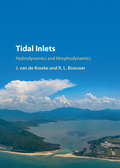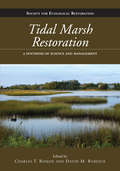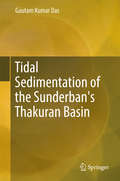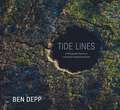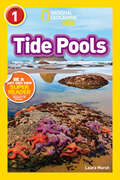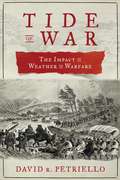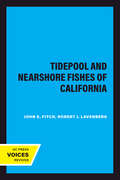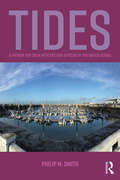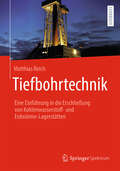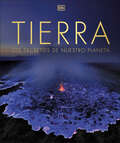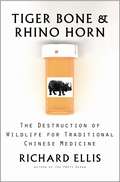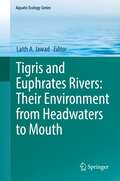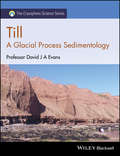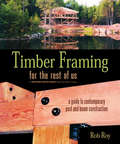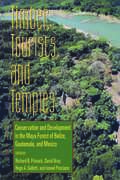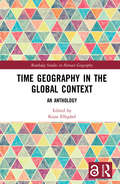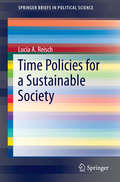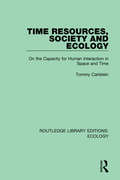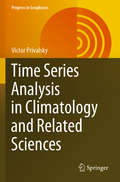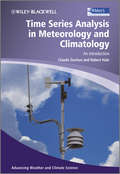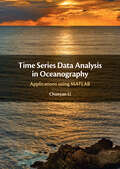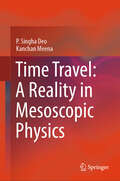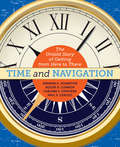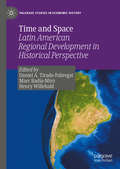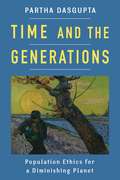- Table View
- List View
Tidal Inlets: Hydrodynamics and Morphodynamics
by J. VAN DE KREEKE R. L. BrouwerThis book describes the latest developments in the hydrodynamics and morphodynamics of tidal inlets, with an emphasis on natural inlets. A review of morphological features and sand transport pathways is presented, followed by an overview of empirical relationships between inlet cross-sectional area, ebb delta volume, flood delta volume and tidal prism. Results of field observations and laboratory experiments are discussed and simple mathematical models are presented that calculate the inlet current and basin tide. The method to evaluate the cross-sectional stability of inlets, proposed by Escoffier, is reviewed, and is expanded, for the first time, to include double inlet systems. This volume is an ideal reference for coastal scientists, engineers and researchers, in the fields of coastal engineering, geomorphology, marine geology and oceanography.
Tidal Marsh Restoration: A Synthesis of Science and Management (Science Practice Ecological Restoration)
by Charles T. Roman David M. BurdickTidal Marsh Restoration provides the scientific foundation and practical guidance necessary for coastal zone stewards to initiate salt marsh tidal restoration programs. The book compiles, synthesizes, and interprets the current state of knowledge on the science and practice of salt marsh restoration, bringing together leaders across a range of disciplines in the sciences (hydrology, soils, vegetation, zoology), engineering (hydraulics, modeling), and public policy, with coastal managers who offer an abundance of practical insight and guidance on the development of programs. The book is an essential work for managers, planners, regulators, environmental and engineering consultants, and others engaged in planning, designing, and implementing projects or programs aimed at restoring tidal flow to tide-restricted or diked salt marshes.
Tidal Sedimentation of the Sunderban's Thakuran Basin
by Gautam Kumar DasThis book covers an overview of research on sediment textures, sedimentary structures, sediment composition and bioturbation structures including other aspects of tidal sedimentation. The analytical results for the tidal river sedimentation and essential aspects of relevant field studies along the entire stretch of the Thakuran River are being presented in this book. Filled with interesting results obtained from minutely observations, this book brings together outstanding facts of the tidal river sedimentation and can be considered as a pioneer work on the dynamic estuarine environment of the Sunderbans River. Anyone in academia or NGOs interested in this river basin will find interesting information in this book that will enrich their knowledge on the sedimentation patterns of tidal river systems.
Tide Lines: A Photographic Record of Louisiana’s Disappearing Coast
by Ben DeppIn Tide Lines: A Photographic Record of Louisiana’s Disappearing Coast, Ben Depp’s photographs capture the beauty, complexity, and rapid destruction of south Louisiana. Once formed by sediment deposited by the Mississippi River, the Louisiana coast is now quickly eroding. Two thousand square miles of wetlands have returned to open water over the past eighty years. Depp’s photographs communicate weather and seasonal changes—like the shifting high-water line, color temperature, and softness of light. A careful observer will notice coastal flora and distinguish living cypress trees from those that have been killed by saltwater intrusion, or see the patterns made by wave energy on barrier island beaches and sediment carried through freshwater diversions from the Mississippi River. With a powered paraglider, Depp flies between ten and ten thousand feet above the ground. He spends hours in the air, camera in hand, waiting for the brief moments when the first rays of sunlight mix with cool predawn light and illuminate forms in the grass, or when evening light sculpts fragments of marsh and geometric patterns of human enterprise—canals, oil platforms, pipelines, and roads. Featuring an introduction by Monique Verdin and over fifty color images, Tide Lines is an intense bird's-eye survey that depicts south Louisiana from an unfamiliar perspective, prompting the viewer to reconsider the value of this vanishing, otherworldly landscape.
Tide Pools (Readers)
by Laura MarshBright starfish, spiky sea anenomes, sea cucumbers, mussels, and colorful fish! Peek into these vibrant shoreline pools and discover amazing ocean habitats teeming with life!Packed with beautiful and engaging photos, this new leveled reader will teach kids how tide pools work, what kinds of animals live in them, and even how to prepare for a tide pool visit of their own.With expert-vetted text, brilliant images, and a fun approach to reading, National Geographic Readers have proved to be a winning formula with kids, parents, and educators. Level 1 text is carefully leveled for an early independent reading or read aloud experience, perfect to encourage the scientists and explorers of tomorrow!
Tide of War: The Impact of Weather on Warfare
by David R. PetrielloThe first comprehensive look at nature’s role on military history. Halley’s Comet helped to announce the fall of the Shang Dynasty in China, a solar eclipse frightened the Macedonian army enough at Pydna in 168 BC to ensure victory for the Romans, a massive rain storm turned the field of Agincourt to mud in 1415 and gave Henry V his legendary victory, fog secured the throne of England for Edward IV at Barnet in 1471, wind and disease conspired to wreck the Spanish Armada, snow served to prevent the American capture of Quebec in 1775 and confined the Revolution to the Thirteen Colonies, and an earthquake helped to spark the Peloponnesian War. But this is only a small sampling of the many instances where nature has tipped the balance in combat. Over the past 4000 years, weather and nature have both hindered and helped various campaigns and battles, occasionally even altering the course of history in the process. Today elements of nature still affect the planning and waging of war, even as we have tried to mitigate its impact. The growing concern over climate change has only heightened the need to study and understand this subject.Tide of War is the first book to comprehensively tackle this topic and traces some of the most notable intersections between nature and war since ancient times.
Tidepool and Nearshore Fishes of California
by John E. Fitch Robert J. LavenbergThis title is part of UC Press's Voices Revived program, which commemorates University of California Press’s mission to seek out and cultivate the brightest minds and give them voice, reach, and impact. Drawing on a backlist dating to 1893, Voices Revived makes high-quality, peer-reviewed scholarship accessible once again using print-on-demand technology. This title was originally published in 1975.This title is part of UC Press's Voices Revived program, which commemorates University of California Press’s mission to seek out and cultivate the brightest minds and give them voice, reach, and impact. Drawing on a backlist dating to 1893, Voices Revived</DIV
Tides: A Primer for Deck Officers and Officer of the Watch Exams
by Philip M. SmithTides: A Primer for Deck Officers and Officer of the Watch Exams prepares the reader for the Officer of the Watch and Master/Mate certificates required by all officers on commercial seagoing vessels. From the formation of tides and tidal stream data, right through to practice questions with answers, and even mock exam papers, this book will provide you with all the reference material you need in order to pass your exams.
Tiefbohrtechnik: Eine Einführung in die Erschließung von Kohlenwasserstoff- und Erdwärme-Lagerstätten
by Matthias ReichDie Tiefbohrtechnik ermöglicht einen Zugriff auf die Erdkruste, der bis zu zehnmal tiefer reicht als die Erschließung von Bergwerken. In diesen extremen Tiefen herrschen enorme Drücke und Temperaturen, bei denen der Mensch nicht überlebensfähig ist. Daher müssen die Bohrgeräte, die nach Rohstoffen suchen, weitgehend autonom arbeiten, um ihr Zielgebiet präzise zu finden. Zu den Rohstoffen, die in den mikroskopisch kleinen Poren des Gesteins verborgen sind, zählen nicht nur Erdgas und Erdöl, sondern auch heißes Wasser, das zur geothermischen Energiegewinnung genutzt werden kann. Die Tiefbohrtechnik ist unverzichtbar für die Energieversorgung unserer hochentwickelten Welt. Sie spielt auch im Rahmen der Energiewende eine zunehmend zentrale Rolle, da sie den Zugang zu alternativen Energiequellen ermöglicht. Das Lehrbuch beschreibt den enormen technischen Aufwand, der notwendig ist, um den tiefen Untergrund sicher, effektiv und mit minimaler Umweltbelastung zu erschließen. Besonderen Wert legt der Autor dabei auf die Verständlichkeit der Inhalte und die Praxisnähe der behandelten Themen. Als langjähriger Dozent an einer der ältesten Montanuniversitäten der Welt, mit umfassender Berufserfahrung in der Öl- und Gasindustrie, sowie als Sachbuchautor und Youtuber mit dem erfolgreichen Kanal „Spaß mit Tiefbohrtechnik“ weiß er, wie man komplexe technische Sachverhalte verständlich und spannend aufbereitet. Die letzten umfassenden Lehrbücher zur Tiefbohrtechnik in deutscher Sprache wurden bereits vor mehreren Jahrzehnten veröffentlicht. Seitdem hat sich die Technologie dramatisch weiterentwickelt. Dieses Buch bietet eine aktuelle und detaillierte Darstellung des Fachgebiets und richtet sich an Studierende, Berufseinsteiger und Fachleute, die ihr Wissen vertiefen möchten, sowie an technisch interessierte Laien, die in die faszinierende Welt der Tiefbohrtechnik eintauchen wollen.
Tierra (The Science of the Earth): Los secretos de nuestro planeta
by DKEsta es una introducción informativa y visualmente llamativa sobre nuestro planeta Tierra. La esencia de este libro son las fotografías grandes y detalladas de objectos concretos, la mayoría lo suficientemente pequeños como para tener en la palma de la mano. Cada objeto revela muchísima información sobre un aspecto en particular de los medios de la Tierra y de su funcionamiento. Por ejemplo, burbujas de aire atrapadas dentro de un núcleo de hielo antártico revelan cómo el clima de la Tierra ha cambiado con el tiempo. Un fragmento de piedra que fue arrojado varias millas al aire por un volcán ayuda a explicar qué sucede cuando las placas tectónicas chocan.El libro está estructurado en torno a un viaje imaginario que lleva al lector del centro a la superficie de la Tierra (incluídas la tierra y los océanos) y hasta las capas superiores de la atmósfera. A través de entornos como pastizales, bosques y arrecifes, 'Tierra' explora reinos vivos e inanimados. Las dobles páginas destacadas ponen el foco en lugares icónicos, como la selva amazónica o el Mar Muerto, o en procesos ecológicos concretos, como la erosión glacial.Muchos de los rincones más fascinantes del mundo natural nos resultan innacesibles: este hermoso e informativo libro los pone a nuestro alcance.This is an informative, visually arresting introduction to planet Earth. The core of the book features large, detailed photographs of single objects, many of them small enough to be held in one hand, that each speak volumes about an aspect of Earth's environments and how they work. For example, bubbles of ancient air trapped inside an Antarctic ice core reveal how Earth's climate has changed over time. A piece of pumice thrown several miles into the air by a volcano helps explain what happens when tectonic plates collide.The book is structured around an imaginary journey that takes the reader from the inner core to Earth's surface (including both land and oceans) and up to the top of the atmosphere. Taking in environments such as grasslands, forests, and reefs, the coverage includes both living and inanimate realms. Feature spreads each throw a spotlight on an iconic place, such as the Amazon Rainforest or the Dead Sea, or a particular process, such as glacial erosion.Many of the most fascinating parts of the natural world are beyond reach. This beautiful, informative book brings them up close and within our grasp.
Tiger Bone & Rhino Horn: The Destruction of Wildlife for Traditional Chinese Medicine
by Richard EllisTiger Bone & Rhino Horns sheds light on the trade in animal parts for traditional Chinese medicine which is a leading cause of species endangerment in Asia.
Tigris and Euphrates Rivers: Their Environment from Headwaters to Mouth (Aquatic Ecology Series #11)
by Laith A. JawadThe system of the Tigris-Euphrates Rivers is one of the great river systems of southwestern Asia. It comprises the Tigris and Euphrates Rivers, which follow roughly parallel courses through the heart of the Middle East. The lower portion of the region that they run through is known as Mesopotamia, was one of the cradles of civilisation. There are several environmental factors that govern the nature of the two rivers and shape the landscape the two rivers running through. Geological events create rivers, climate monitor the water supply, the surrounding land influences the vegetation and the physical and chemical features of water. The Tigris-Euphrates system runs through the territory of four countries, Iraq, Iran, Turkey and Syria. Therefore, any scientific approach to the environment of these two rivers should include the natural history events in these countries. The book "Tigris and Euphrates Rivers: Their Environment from Headwaters to Mouth" will be divided into nine parts. These parts deal with the issues of the environment, the status of the flora and fauna, the abiotic aspects, ecology, hydrological regime of the two rivers, the biotic aspects. Water resources, stress of the environment, conservation issues. Since the book of Julian Rzoska "Euphrates and Tigris Mesopotamian Ecology and Destiny" in 1980, no book or major reference has been published that includes between its cover the facts and information that the present book will present. Therefore, the importance of the present book falls in stating the present status of the environment of the two rivers and the comparison of their environment between now and that of 37 years ago as given by J. Rzoska (1980). The recent studies showed that there are a large number of natural and political events that happened within the last three decades in the area of the Tigris-Euphrates river system that for sure have done a great change to the environment of the two rivers and consequently changing the biological and non-biological resources of the two rivers. This book will be a reference book to both Academic and students across the Middle East in different disciplines of knowledge to use in their researches on Tigris-Euphrates river system. The scholars interested in this area will use this book as a guide to compare this freshwater system with other areas in Asia and the world.
Till: A Glacial Process Sedimentology (The Cryosphere Science Series)
by David J. EvansProvides the first comprehensive review of the current state of the science on tills It is critical that glacial scientists continue to refine their interpretations of ancient archives of subglacial processes, specifically those represented by tills and associated deposits, as they form the most widespread and accessible record of processes at the ice-bed interface. Unfortunately, despite a long history of investigation and a lexicon of process-based nomenclature, glacial sedimentologists have yet to reach a consensus on diagnostic criteria for identifying till genesis in the geological record. What should be called till? Based on the author’s extensive field research, as well as the latest literature on the subject, this book attempts to provide a definitive answer to that question. It critically reviews the global till literature and experimental and laboratory-based assessments of subglacial processes, as well as the theoretical constructs that have emerged from process sedimentology over the past century. Drawing on a wide range of knowledge bases, David Evans develops a more precise, contemporary till nomenclature and new investigatory strategies for understanding a critical aspect of glacial process sedimentology. Provides an in-depth discussion of subglacial sedimentary processes, with an emphasis on the origins of till matrix and terminal grade and the latest observations on till evolution Describes contemporary laboratory and modelling experiments on till evolution and techniques for measuring strain signatures in glacial deposits Develops an updated till nomenclature based on an array of knowledge bases and describes new strategies for field description and analysis of glacial diamictons Written by an internationally recognised expert in the field, this book represents an important step forward in the modern understanding of glacial process sedimentology. As such, Till: A Glacial Process Sedimentology is an indispensable resource for advanced undergraduates and researchers in sedimentology, glacier science and related areas.
Timber Framing for the Rest of Us
by Rob RoyMany natural building methods rely upon the use of post and beam frame structures that are then in-filled with straw, cob, cordwood, or more conventional wall materials. But traditional timber framing employs the use of finely crafted jointing and wooden pegs, requiring a high degree of craftsmanship and training, as well as much time and expense. However, there is another way . . .Timber Framing for the Rest of Us describes the timber framing methods used by most contractors, farmers and owner-builders--methods that use modern metal fasteners, special screws and common sense building principles to accomplish the same goal in much less time. And while there are many good books on traditional timber framing, this is the first to describe in depth these more common fastening methods. The book includes everything an owner-builder needs to know about building strong and beautiful structural frames from heavy timbers, including: the historical background of timber framing crucial design and structural considerations procuring timbers--including different woods and recycled materials foundations, roofs and in-filling considerations the common fastenersA detailed case study of a timber frame project from start to finish completes this practical and comprehensive guide, along with a useful appendix of span tables and a bibliography.Highly illustrated, this book enables "the rest of us" to build like the professionals and will appeal to owner-builders, contractors and architects alike.Rob Roy is a former contractor with 11 previous books to his credit. He has been utilizing timber framing techniques for the past 25 years in the construction of homes, as well as in the numerous outbuildings at Earthwood Building School which he founded in 1981 with his wife, Jaki. He is most recently the author of Cordwood Building: The State of the Art (New Society, 2003).
Timber, Tourists, and Temples: Conservation And Development In The Maya Forest Of Belize Guatemala And Mexico
by Richard B. Primack Ismael Ponciano David Bray Hugo A. GallettiStretching across southern Mexico, northern Guatemala, and Belize, the Maya Forest, or Selva Maya, constitutes one of the last large blocks of tropical forest remaining in North and Central America. Home to Mayan-speaking people for more than 5,000 years, the region is also uncommonly rich in cultural and archaeological resources.Timber, Tourists, and Temples brings together the leading biologists, social scientists, and conservationists working in the region to present in a single volume information on the intricate social and political issues, and the complex scientifc and management problems to be resolved there. Following an introductory chapter that presents GIS and remote sensing data, the book: considers perspectives on managing forest resources and the forestry and conservation policies of each nation examines efforts by communities to manage their forest resources explains the connections between resource conservation and use by local people highlights research projects that integrate baseline biological research with impact assessments explains the need to involve local people in conservation effortTimber, Tourists, and Temples explores methods of supporting the biological foundation of the Maya Forest and keeping alive that unique and diverse ecosystem. While many areas face similar development pressures, few have been studied as much or for as long as the Maya Forest. The wealth of information included in this pathbreaking work will be valuable not only for researchers involved with the Maya Forest but for anyone concerned with the protection, use, and management of tropical forest ecosystems throughout the world.
Time Geography in the Global Context: An Anthology (Routledge Studies in Human Geography)
by Kajsa EllegårdTime-geography is a mode of thinking that helps us understand change processes in society, the wider context and the ecological consequences of human actions. This book brings together international time-geographic research from a range of disciplines. Swedish geographer Torsten Hägerstrand is a key foundation for this book, and an introductory biography charts the influences that led to the formation of his theories. A central theme across time-geography research is recognizing time and space as unity. Contributions from the Netherlands, the USA, Japan, China, Norway and Sweden showcase the diverse palette of time-geography research. Chapters study societies adjusting to rapid urbanization, or investigate the need for structural changes in childcare organization. The book also delves into green transportation and the interplay between humans and nature in landscape transformation. Applicational chapters look at ICT effects on young people’s daily life and methods for engaging clients in treatment practice. This book situates the outlook for this developing branch of research and the application of time-geography to societal and academic contexts. Its interdisciplinary nature will appeal to postgraduates and researchers who are interested in human geography, urban and regional planning and sociology.
Time Policies for a Sustainable Society
by Lucia A. ReischThis book explores time use, time policy, well-being and sustainable development using concepts and findings from time policy research, socio-ecological sustainability research, behavioral economics, consumer research, and research into prosperity and "the good life". Because any change in time structures, whether opening or working hours, school or travel times, has large scale impacts on other times that should ideally be recognized, the political and social restructure and negotiations for more effective time policy must include cross-cutting issues in the relevant sector policies - family, health, consumer, diet, environment, education, technology, transport, urban and labor market policy - and develop time policy strategies and instruments specific to each sector. This book is an interdisciplinary look into how society and government structure time policy, the procedural component of and possibility of a transformation or improvement in time-use, i. e. the "how" of change, what are transformation processes, how can they be explained, and how can change processes be ideally shaped? This book outlines the possibility of a transformation to sustainability in time policy. It will be of interest to researchers in economics, social and political science, social policy, government, quality of life studies, and education.
Time Resources, Society and Ecology: On the Capacity for Human Interaction in Space and Time (Routledge Library Editions: Ecology #1)
by Tommy CarlsteinOriginally published in 1982, Time Resources, Society and Ecology examines and seeks to examine the time dimension in terms of the ecology, technology, social organization and spatial structure of the human habitat. Approaches to time resources – sociological time-budget studies, anthropological activity analysis, and economic analysis of money allocation – have been limited by their sectoral scope or their failure to relate effectively to the processes of social interaction, technological change and environmental structure. In this book, the book’s articulation of time resources is developed in a general theoretical framework of action and interaction in time and space. The book examines constraints and possibilities facing preindustrial societies and throws light on the impact of technology on modern societies. Basic models of time allocation are presented, and, finally, a cross-cultural comparison is made of the mobilization of time resources in preindustrial societies. Geographers, social anthropologists and human ecologists should find this work directly relevant to their interest in understanding the interactions between man and environment.
Time Series Analysis in Climatology and Related Sciences (Progress in Geophysics)
by Victor PrivalskyThis book gives the reader the basic knowledge of the theory of random processes necessary for applying to study climatic time series. It contains many examples in different areas of time series analysis such as autoregressive modelling and spectral analysis, linear extrapolation, simulation, causality, relations between scalar components of multivariate time series, and reconstructions of climate data. As an important feature, the book contains many practical examples and recommendations about how to deal and how not to deal with applied problems of time series analysis in climatology or any other science where the time series are short.
Time Series Analysis in Meteorology and Climatology
by Robert Hale Claude DuchonTime Series Analysis in Meteorology and Climatology provides an accessible overview of this notoriously difficult subject. Clearly structured throughout, the authors develop sufficient theoretical foundation to understand the basis for applying various analytical methods to a time series and show clearly how to interpret the results. Taking a unique approach to the subject, the authors use a combination of theory and application to real data sets to enhance student understanding throughout the book.This book is written for those students that have a data set in the form of a time series and are confronted with the problem of how to analyse this data. Each chapter covers the various methods that can be used to carry out this analysis with coverage of the necessary theory and its application. In the theoretical section topics covered include; the mathematical origin of spectrum windows, leakage of variance and understanding spectrum windows. The applications section includes real data sets for students to analyse. Scalar variables are used for ease of understanding for example air temperatures, wind speed and precipitation.Students are encouraged to write their own computer programmes and data sets are provided to enable them to recognize quickly whether their programme is working correctly- one data set is provided with artificial data and the other with real data where the students are required to physically interpret the results of their periodgram analysis.Based on the acclaimed and long standing course at the University of Oklahoma and part of the RMetS Advancing Weather and Climate Science Series, this book is distinct in its approach to the subject matter in that it is written specifically for readers in meteorology and climatology and uses a mix of theory and application to real data sets.
Time Series Data Analysis in Oceanography: Applications using MATLAB
by Chunyan LiChunyan Li is a course instructor with many years of experience in teaching about time series analysis. His book is essential for students and researchers in oceanography and other subjects in the Earth sciences, looking for a complete coverage of the theory and practice of time series data analysis using MATLAB. This textbook covers the topic's core theory in depth, and provides numerous instructional examples, many drawn directly from the author's own teaching experience, using data files, examples, and exercises. The book explores many concepts, including time; distance on Earth; wind, current, and wave data formats; finding a subset of ship-based data along planned or random transects; error propagation; Taylor series expansion for error estimates; the least squares method; base functions and linear independence of base functions; tidal harmonic analysis; Fourier series and the generalized Fourier transform; filtering techniques: sampling theorems: finite sampling effects; wavelet analysis; and EOF analysis.
Time Travel: A Reality in Mesoscopic Physics
by P. Singha Deo Kanchan MeenaThis book is aimed at postgraduate and Ph.D. students specializing in condensed matter physics, quantum mechanics, and the theory of relativity. It explores fundamental problems in physics that can be addressed in the mesoscopic regime. Some of the key topics covered include: a) The state of a tunneling particle under a barrier b) A local description of the state of a quantum particle c) Reality of time travel leading to reconciliation of the classical and quantum laws The book also sets the stage for developing an alternative description of quantum mechanics and how scattering phase shift can be used to probe local density of states. It highlights essential differences from traditional statistical mechanics and discusses the potential applications and future technologies stemming from breakthroughs in basic science, which will be of interest to researchers.
Time and Navigation
by Paul E. Ceruzzi Carlene E. Stephens Roger D. Connor Andrew K. JohnstonIf you want to know where you are, you need a good clock. The surprising connection between time and place is explored in Time and Navigation: The Untold Story of Getting from Here to There, the companion book to the National Air and Space Museum exhibition of the same name.Today we use smartphones and GPS, but navigating has not always been so easy. The oldest "clock" is Earth itself, and the oldest means of keeping time came from observing changes in the sky. Early mariners like the Vikings accomplished amazing feats of navigation without using clocks at all. Pioneering seafarers in the Age of Exploration used dead reckoning and celestial navigation; later innovations such as sextants and marine chronometers honed these techniques by measuring latitude and longitude. When explorers turned their sights to the skies, they built on what had been learned at sea. For example, Charles Lindbergh used a bubble sextant on his record-breaking flights. World War II led to the development of new flight technologies, notably radio navigation, since celestial navigation was not suited for all-weather military operations. These forms of navigation were extended and enhanced when explorers began guiding spacecraft into space and across the solar system. Astronauts combined celestial navigation technology with radio transmissions. The development of the atomic clock revolutionized space flight because it could measure billionths of a second, thereby allowing mission teams to navigate more accurately. Scientists and engineers applied these technologies to navigation on earth to develop space-based time and navigation services such as GPS that is used every day by people from all walks of life.While the history of navigation is one of constant change and innovation, it is also one of remarkable continuity. Time and Navigation tells the story of navigation to help us understand where we have been and how we got there so that we can understand where we are going.
Time and Space: Latin American Regional Development in Historical Perspective (Palgrave Studies in Economic History)
by Henry Willebald Daniel A. Tirado-Fabregat Marc Badia-MiróThis edited collection examines the evolution of regional inequality in Latin America in the long run. The authors support the hypothesis that the current regional disparities are principally the result of a long and complex process in which historical, geographical, economic, institutional, and political factors have all worked together. Lessons from the past can aid current debates on regional inequalities, territorial cohesion, and public policies in developing and also developed countries. In contrast with European countries, Latin American economies largely specialized in commodity exports, showed high levels of urbanization and high transports costs (both domestic and international). This new research provides a new perspective on the economic history of Latin American regions and offers new insights on how such forces interact in peripheral countries. In that sense, natural resources, differences in climatic conditions, industrial backwardness and low population density areas leads us to a new set of questions and tentative answers. This book brings together a group of leading American and European economic historians in order to build a new set of data on historical regional GDPs for nine Latin American countries: Argentina, Bolivia, Brazil, Chile, Colombia, Mexico, Peru, Uruguay and Venezuela. This transnational perspective on Latin American economic development process is of interest to researchers, students and policy makers.
Time and the Generations: Population Ethics for a Diminishing Planet (Kenneth J. Arrow Lecture Series)
by Partha DasguptaHow should we evaluate the ethics of procreation, especially the environmental consequences of reproductive decisions on future generations, in a resource-constrained world? While demographers, moral philosophers, and environmental scientists have separately discussed the implications of population size for sustainability, no one has attempted to synthesize the concerns and values of these approaches. The culmination of a half century of engagement with population ethics, Partha Dasgupta’s masterful Time and the Generations blends economics, philosophy, and ecology to offer an original lens on the difficult topic of optimum global population.After offering careful attention to global inequality and the imbalance of power between men and women, Dasgupta provides tentative answers to two fundamental questions: What level of economic activity can our planet support over the long run, and what does the answer say about optimum population numbers? He develops a population ethics that can be used to evaluate our choices and guide our sense of a sustainable global population and living standards. Structured around a central essay from Dasgupta, the book also features a foreword from Robert Solow; correspondence with Kenneth Arrow; incisive commentaries from Joseph Stiglitz, Eric Maskin, and Scott Barrett; an extended response by the author to them; and a joint paper with Aisha Dasgupta on inequalities in reproductive decisions and the idea of reproductive rights. Taken together, Time and the Generations represents a fascinating dialogue between world-renowned economists on a central issue of our time.
